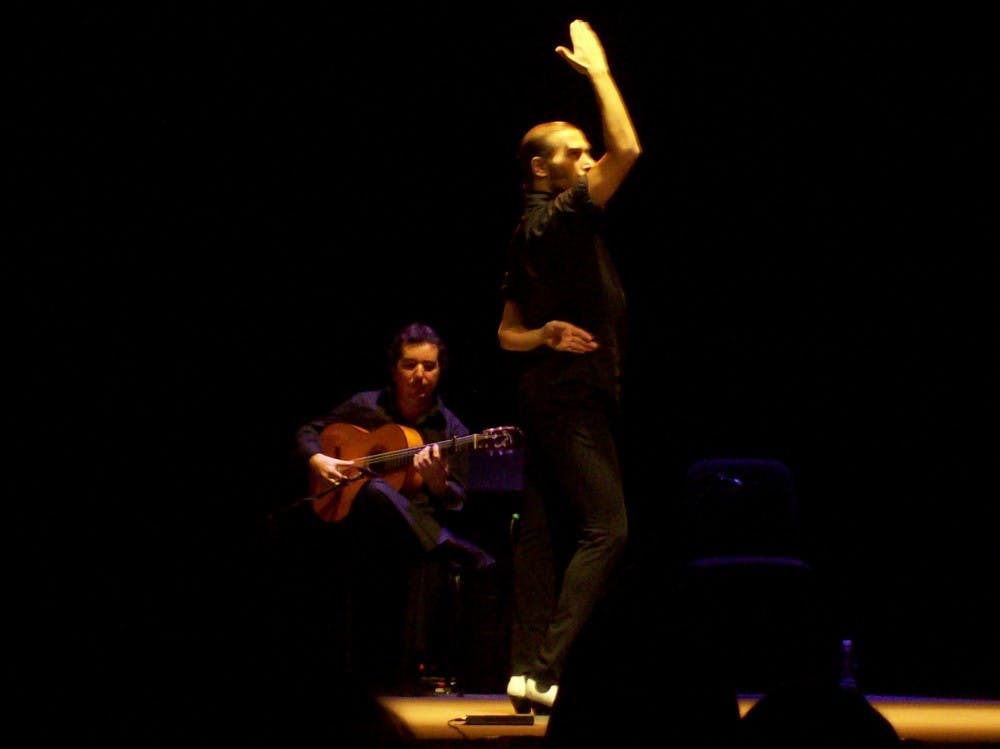The stage goes black. Royal blue light shines from the ceiling down onto three chairs placed at center stage. One by one, the seats are filled and a Spanish guitar begins to play. A singer joins the acoustics, singing with deep, powerful emotions that fill the theater and the ears of the audience. Then, the light shining on the third chair becomes brighter as a dancer springs to life and joins the other two performers to complete the trio. With his grand movements and facial expressions, it is a mesmerizing and accurate demonstration of Spanish flamenco.
The flamenco dance originated in southern Spain — Andalucía, to be exact — and has deep roots within the Spanish culture and history. Often referred to as el baile del gitano (the gypsy’s dance), the Spanish developed the dance and song by expressing their thoughts and emotions about life. Flamenco includes a variety of emotions, from joyous dancing to sorrowful singing. Either way, it is a powerful form of expression that shows a different side of artistic expression.
Flamenco is composed of three pieces: cante (the song), baile (the dance) and toque (the music). The singing is often centered on social problems the gypsies faced when living in caves in Spain, as well as love and complicated relationships. The guitar helps to set the mood with the tempo, progression and repetition of chords. The dancing, perhaps the most entertaining of all, mirrors the emotion created by the singing, often telling a story through body language and las palmas (hands). When all three are meshed together, an exciting and energetic performance is sure to be had.
It is not uncommon for those new to the flamenco scene to be taken aback upon seeing a performance for the first time. The elaborate costumes, fast-paced footwork and high-volume acoustics all make for a dramatic performance, taking the visual arts to a whole different level. Traditional flamenco involves a group of three to five musicians with instruments including the guitar, tambourine, bass and even violin. There is normally one singer, although the musicians will also voice their enthusiasm for the performance. There can be as few as one dancer or an entire troupe of performers who take turns showing off their skills and creating a story through their interactions with the others.
While flamenco is a traditional Spanish dance, it is growing quickly in popularity all over the world (a flamenco craze is even taking root in Japan) and becoming incorporated into many Latin American cultures. A new wave of flamenco is evolving as artists are adding a fresh spin on the dance to express their style of performing. Events such as flamenco festivals allow these artists to share their unique style and bring awareness to the transforming art. They are held throughout the year and many restaurants and cafés provide customers with the opportunity to experience a Flamenco performance.
The Flamenco Festival in Washington, D.C., is one such event that celebrates the art of flamenco through some of Spain’s leading traditional and contemporary performers. This year, the Lisner Auditorium at the George Washington University hosted the 10th annual festival.
The festival began on Feb. 9 with a performance by a group of accomplished flamenco dancers who ensured this festival would be exceptional. Artists during the festival included Pastora Galván from Sevilla, María Pagés from Sevilla, Rocío Molina from Málaga and Israel Galván from Sevilla. Each of the performances was unique, bringing something different and original that illustrated multiple aspects of flamenco.
Israel Galván was the final performer of the festival and certainly put on an incredible show. An excellent example of new wave flamenco, Galván is famous for his rapid footwork, followed by stillness and slow movements. The stage comes to life with the sounds of the guitar and singer, David and Alfredo Lagos, who each incorporated their own solo pieces into the dance.
Galván grew up in a family immersed in the flamenco culture. With a mother and father who both dance, and the latter directing a dance academy in Spain, Galván became a professional dancer at the age of 18.
“There is never a day when I am not dancing,” he said after the performance.
Galván seems to have created his own niche, which can be best described as non-conforming, replacing the cliché flamenco patterns with long steps across the stage, intricate hand formations and a presence that captivated the audience during the entire hour and a half. The encore included an unexpected “cambio del rol,” through which the singer played the guitar, Galván sang and the guitarist stamped around the stage clapping his hands — an entertaining finale for sure.
Bringing more awareness to the growth of flamenco nations where Spanish is a common language, such as the United States, is important to the success of flamenco and allows other cultures to evolve artistically. For upcoming events at the Lisner Auditorium, visit www.lisner.org. For further information on local D.C. flamenco events, visit www.dcflamenco.com.
You can reach this writer at thescene@theeagleonline.com.





